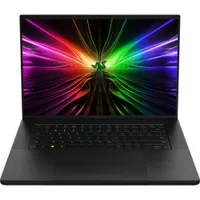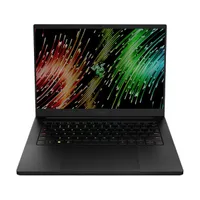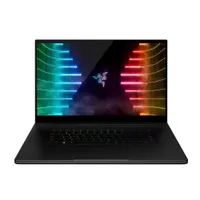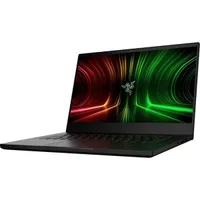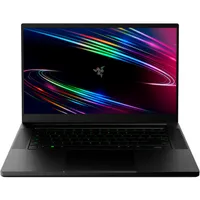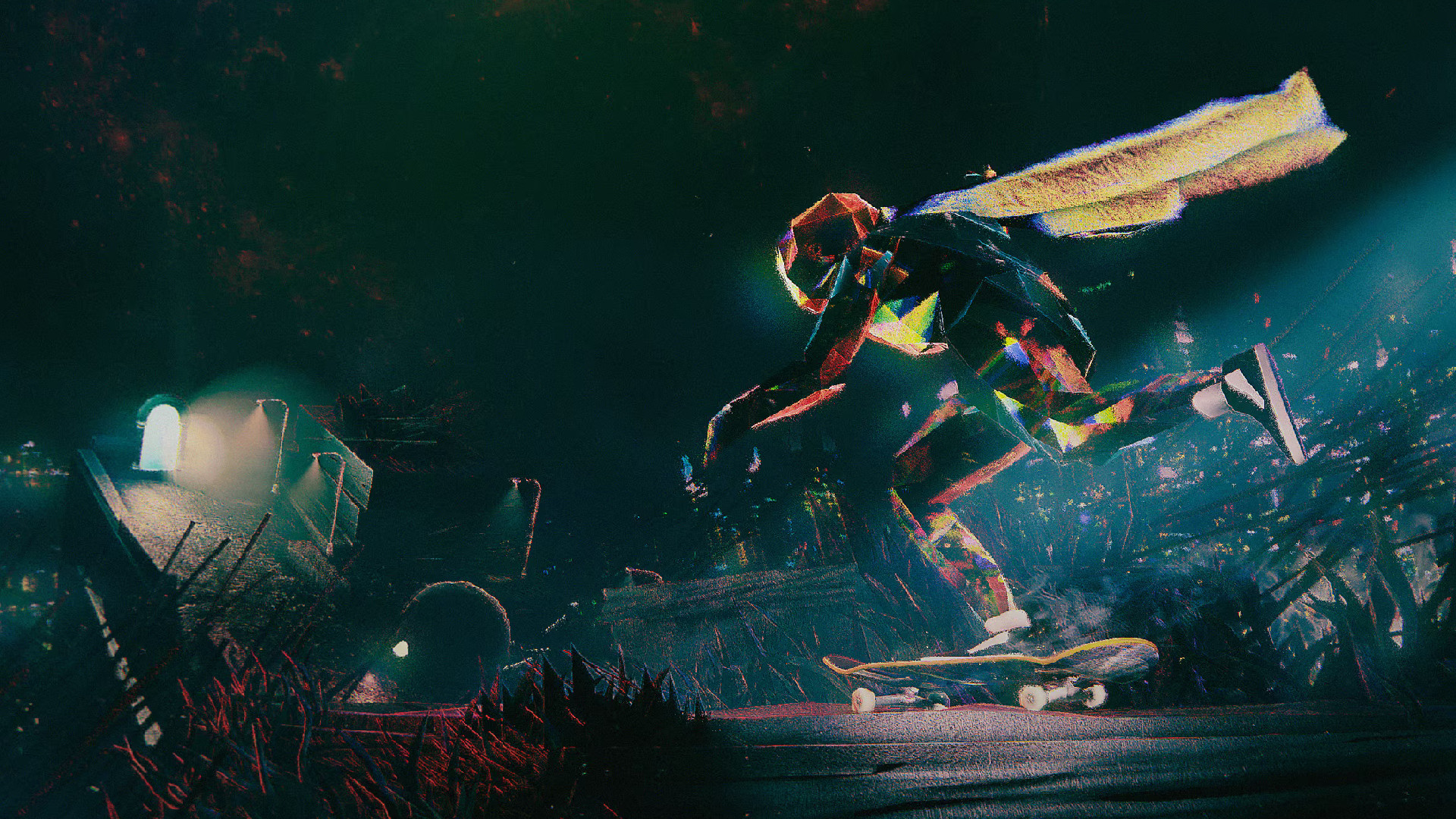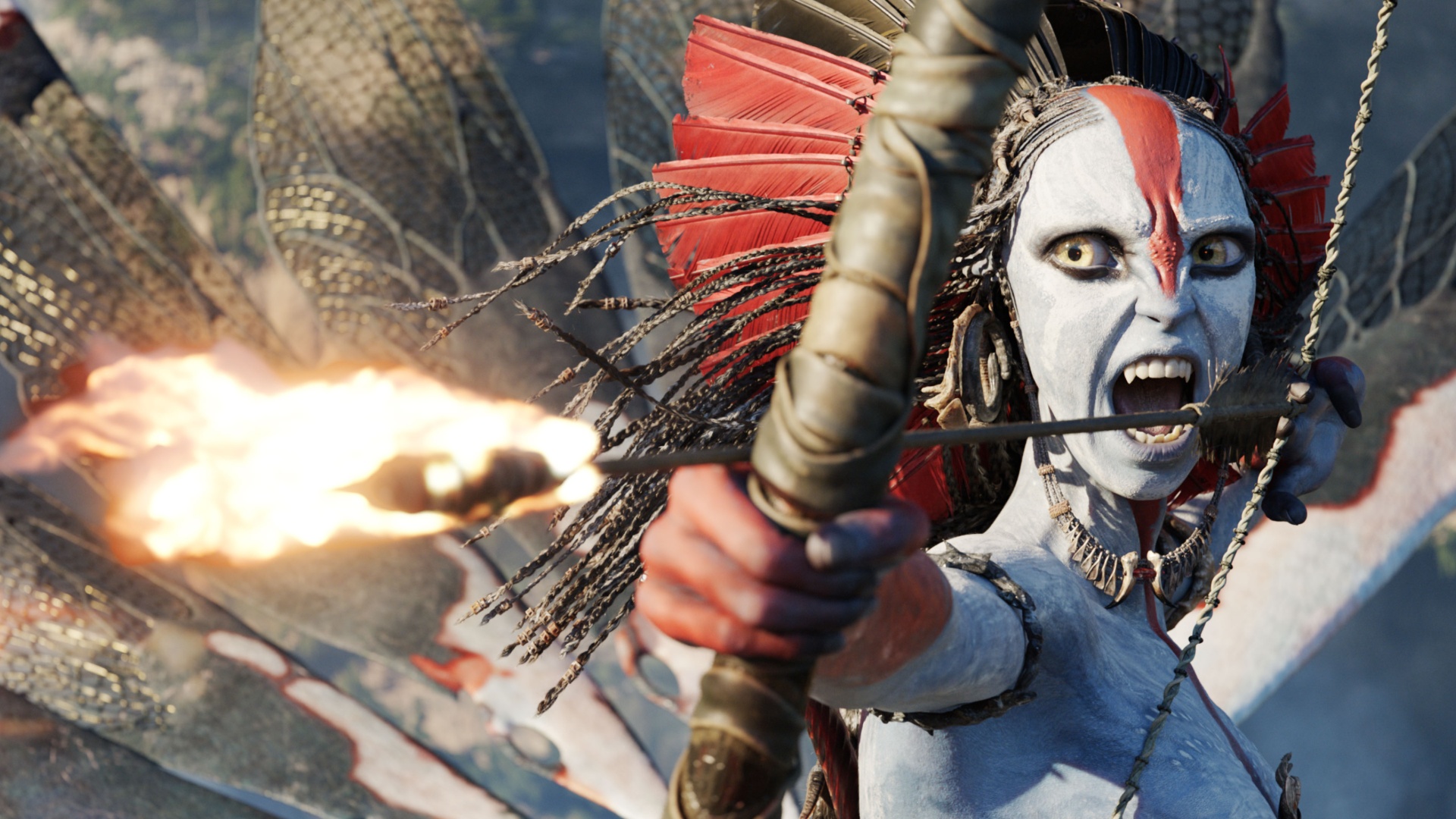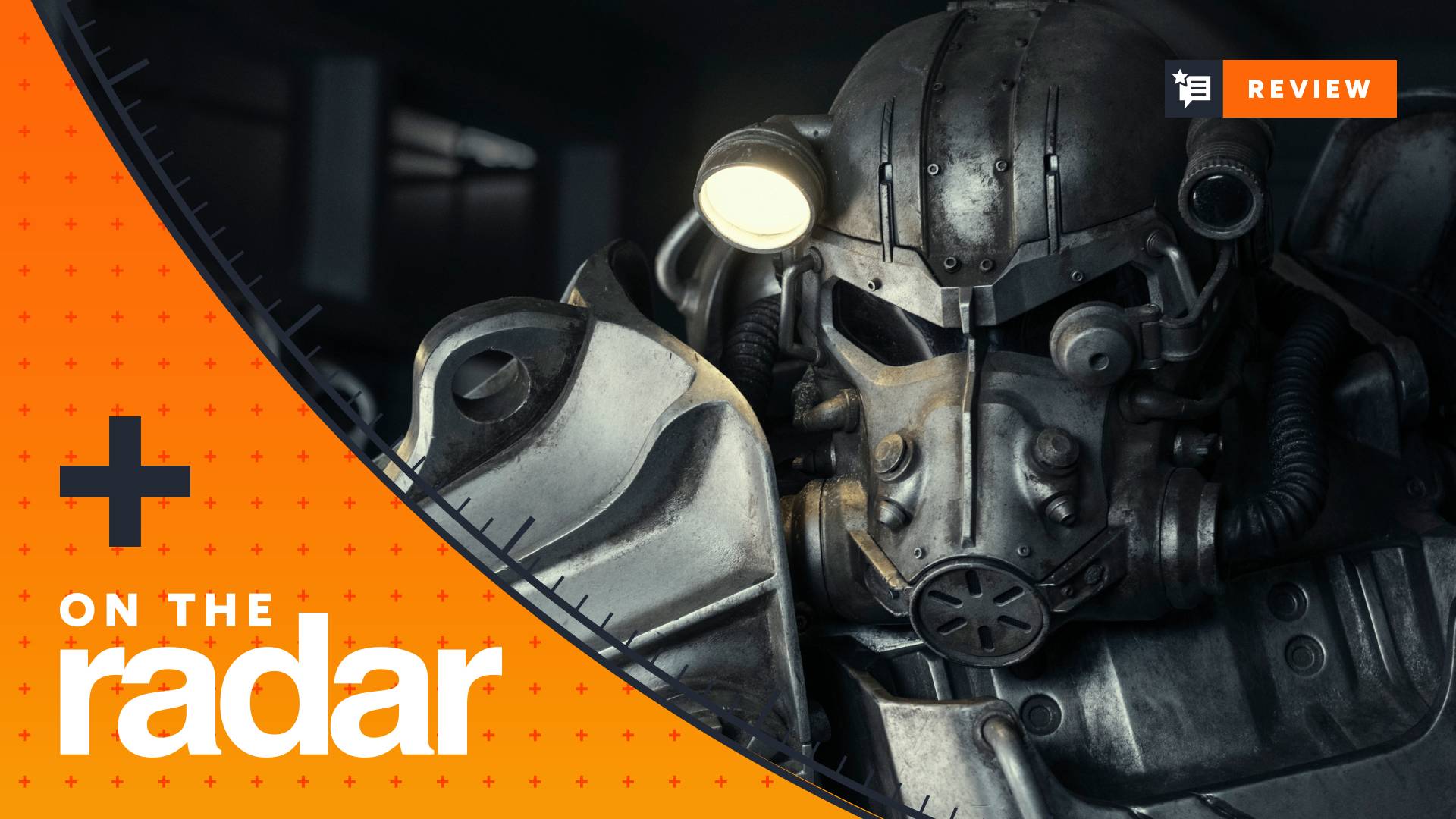The best Razer laptops in 2025
Blend build quality, power, and performance for a truly powerful gaming machine
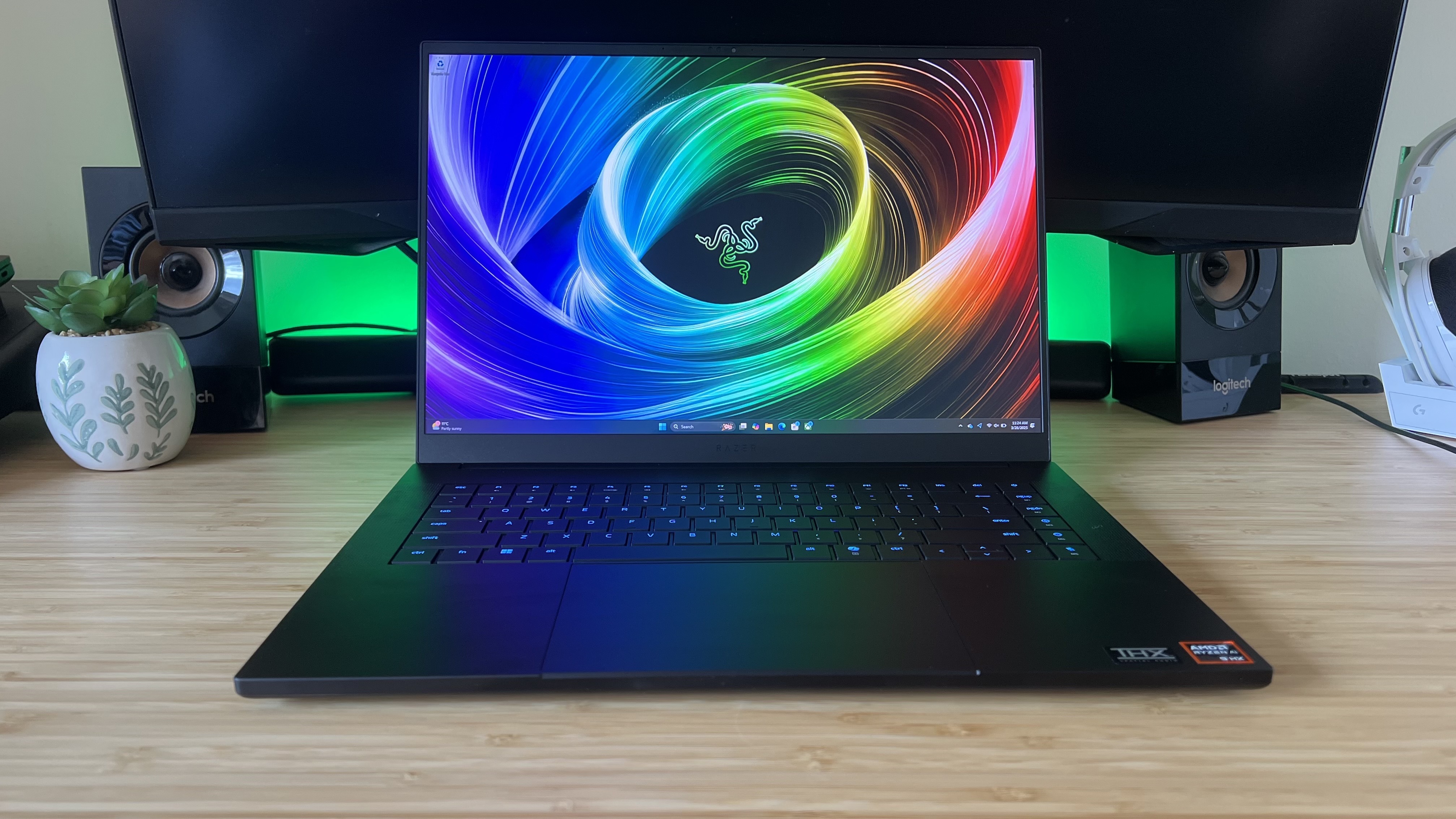
The best Razer laptops offer some of the highest quality OLED panels on the market, alongside some of the slimmest waistlines but these premium rigs aren't going to be for everyone. The Blade 14, 16, and 18 all offer their own benefits and range of GPU options, but if you're looking for something straight down the middle, the middle child is going to be your go-to.
The Blade 16 is the best Razer laptop I've tested yet, but if you're after something more portable the 14-inch model is a much better pick. Of course, if you're going all out on a desktop replacement, but still want the slimline design Sneki's known for there's always the gut-busting Blade 18 as well.
These are some of the best gaming laptops on the market, and they certainly cost a pretty penny. However, I've seen discounts hitting these machines with far more vigor than the previous generation. The Blade 16 itself has seen price lows of $1,799 (for an RTX 5060 model) in the US - not bad considering it starts life as a $2,000+ rig.
The quick list
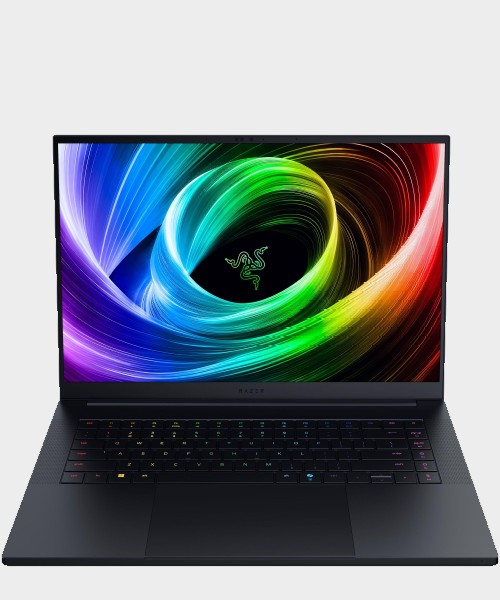
The Razer Blade 16 is your go-to if you're after a traditional gaming laptop experience, a screen big enough to feel immersive but a slimline design that still keeps things light.
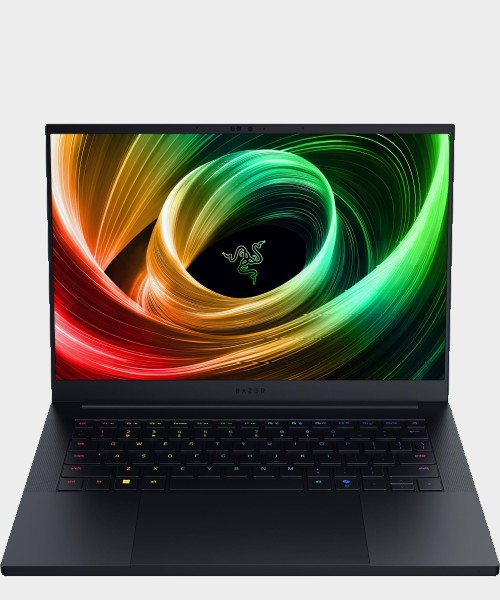
The Blade 14 is best for those looking to take their laptop on the road. The 2025 release is the brand's slimmest model to date and, while it drops down a few GPU rungs, it's also sporting an OLED display for the first time.
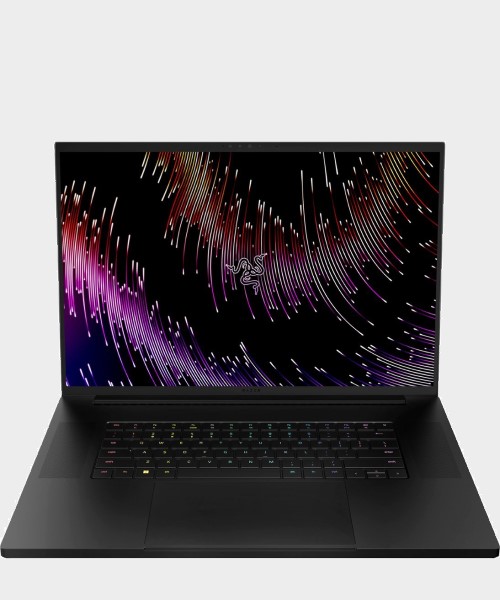
The most powerful Razer Blade laptop is the Blade 18, with a wider chassis space to help all those high-end components run as smoothly as possible.

I've been reviewing gaming laptops at GamesRadar+ for four years and have leapt at the chance to get my hands on all the latest and greatest rigs bearing the mystical green snake logo. I've developed an eye not just for performance and day-to-day ease of use of each machine, but also the value for money on offer as well. My daily driver is an RTX 4070 Razer Blade 14.
October 16 - The new Razer Blade 14 has firmly settled into its position at number two on this list. It's the best Razer laptop for those who prioritize portability over raw power, just be wary of the limited configurations.
The best Razer laptop overall
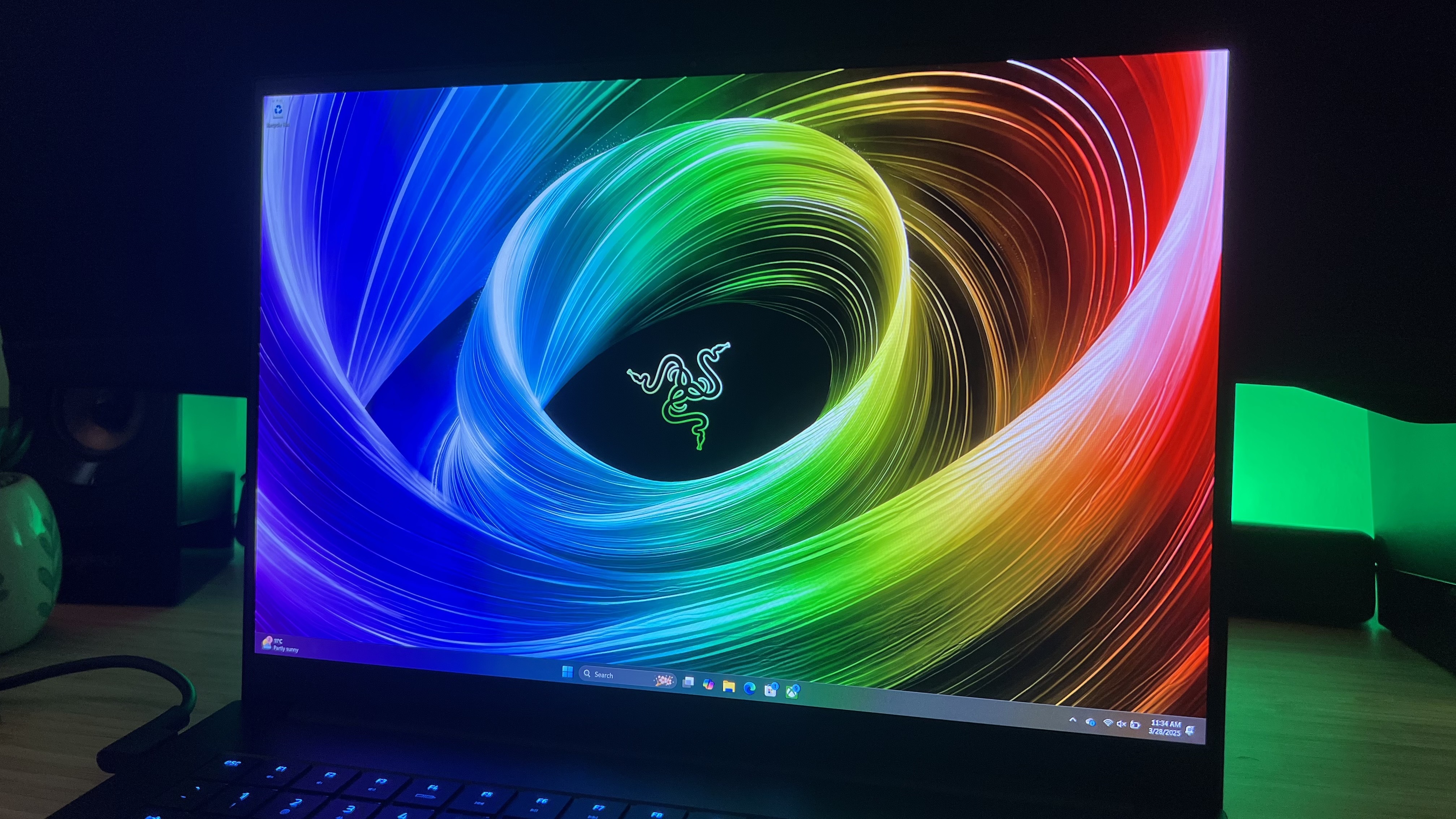
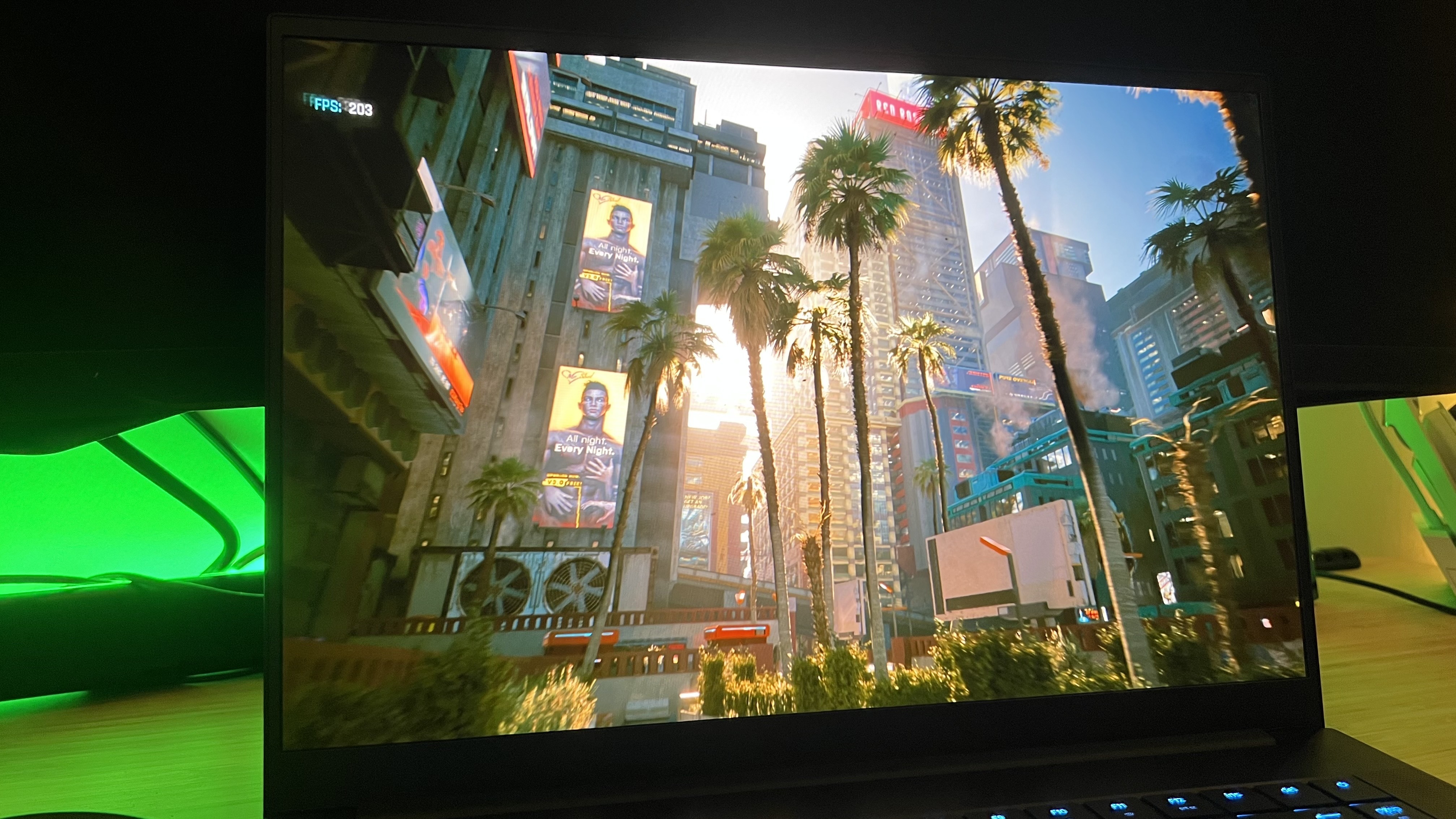
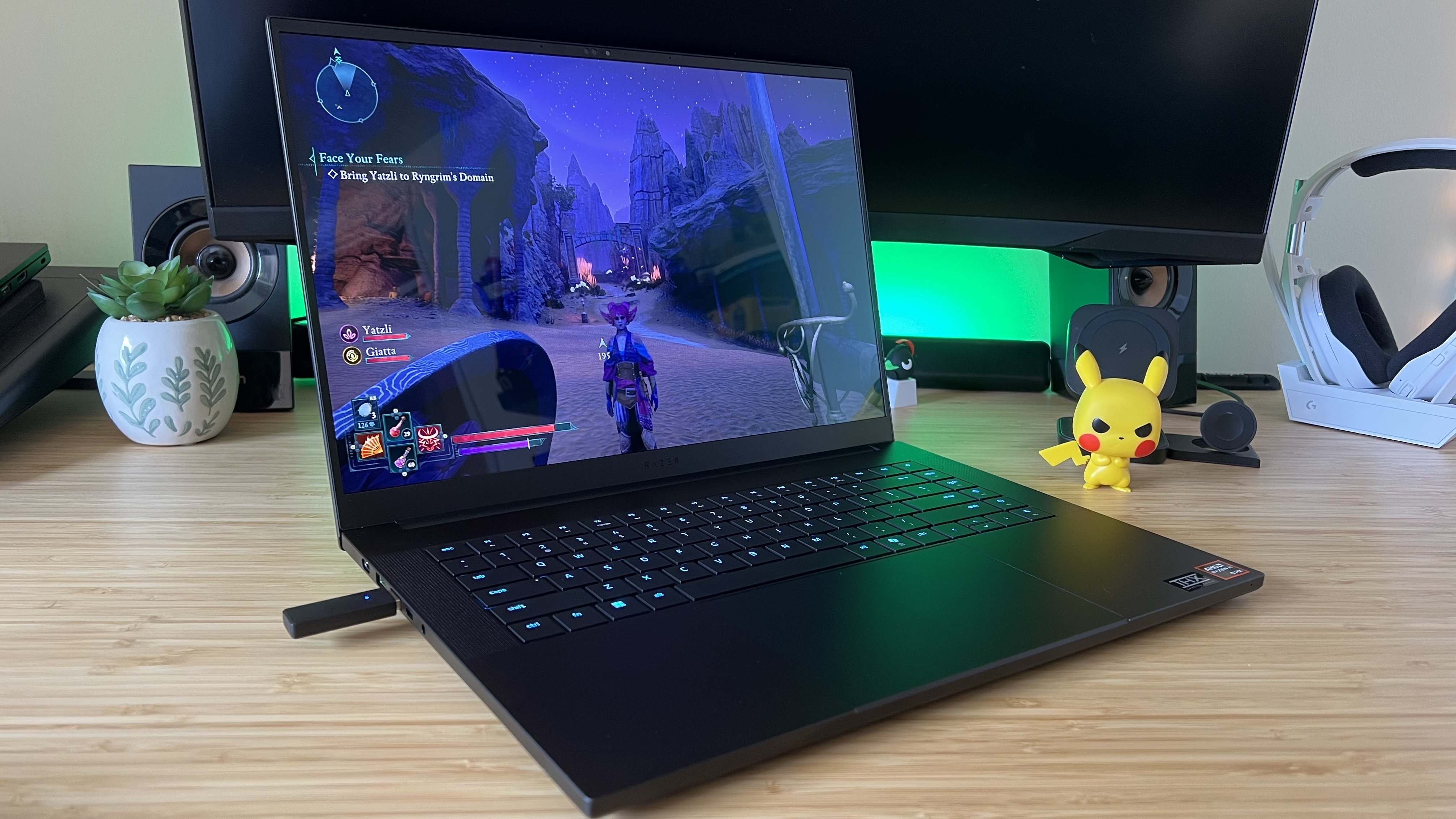
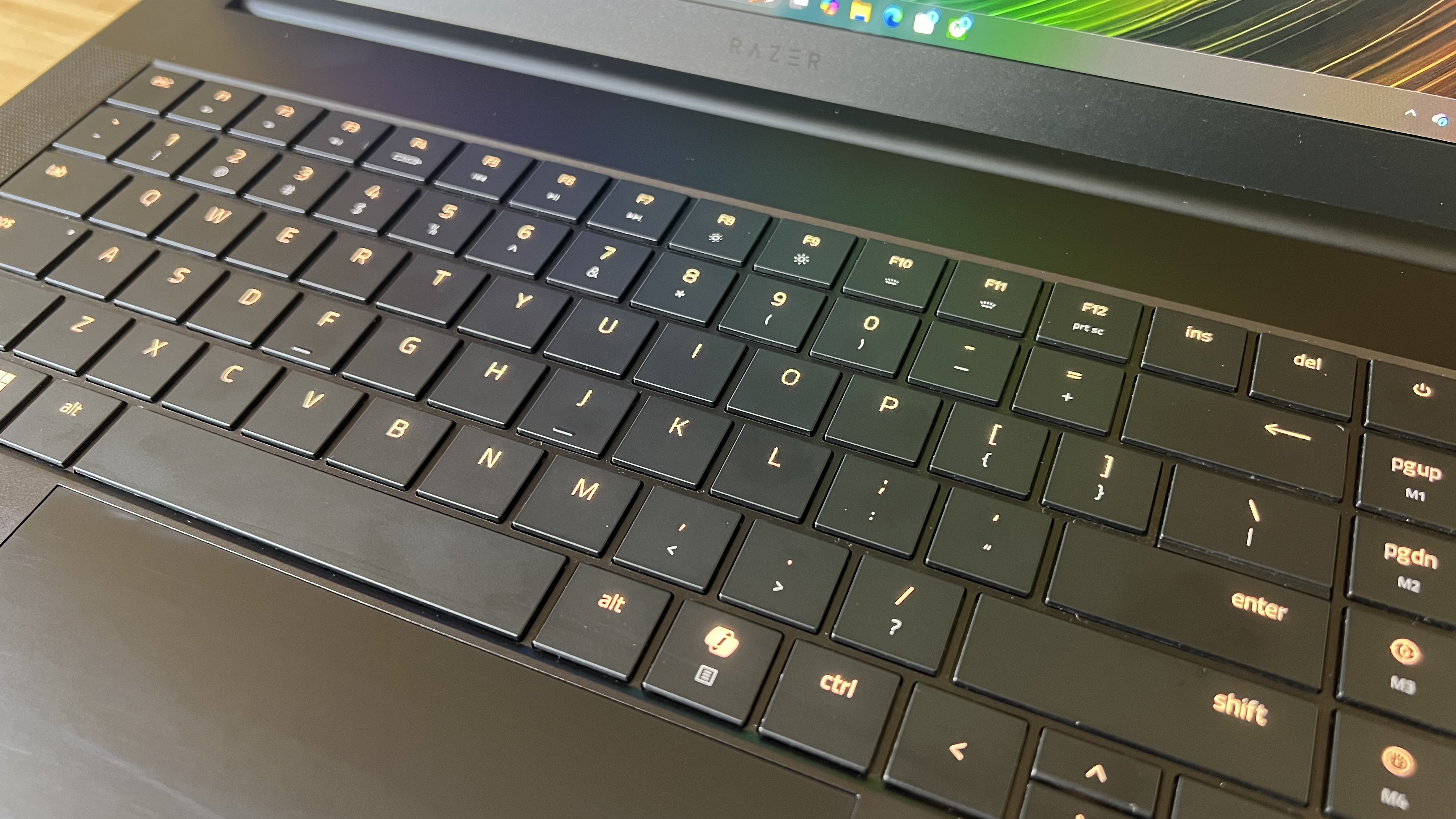
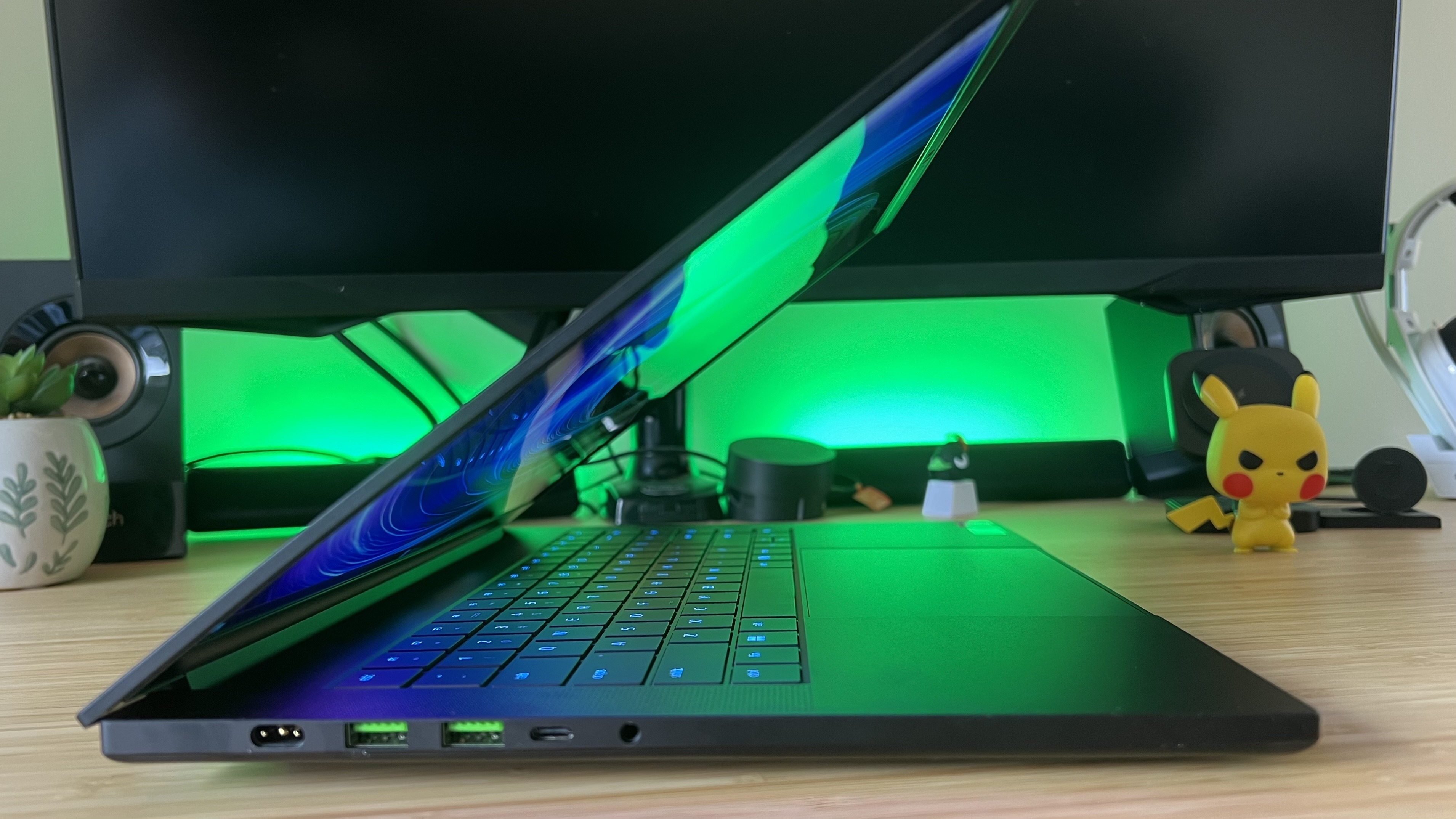
Specifications
Reasons to buy
Reasons to avoid
The 2025 Razer Blade 16 shrinks the form factor into a super-skinny design that would have previously been impossible, all while still offering more than playable framerates in demanding games and boosting the battery. That's no mean feat, and considering we've still got the best display I've ever used on a gaming laptop (and a massively improved keyboard underneath it), this is a stunner.
The new Blade 16 is an ultra-slim device, barely having enough space for its USB-A ports on the side flanks, but it's the OLED panel that really impresses me. This is the same screen as the previous generation, but it still sings beautifully, offering super vivid colors and excellent vibrancy. The scissor switch keyboard feels bouncy and responsive, with a longer 1.5mm key travel for a more satisfying experience overall.
Under the hood, Razer has gone with AMD's AI processors for this generation, with the Ryzen AI 9 HX 370 heading up the flagship RTX 5090 configuration. These are leaner CPUs with more of a focus on efficiency, so they don't provide as much grunt as the Intel i9-14900HX inside the previous generation. That drop did show itself during benchmarking.
The RTX 5090 model I tested performed similarly to the RTX 4090 version I had on the desk last year. It's impressive that these numbers were maintained and often slightly exceeded in a much smaller form factor and with a lower TGP, but it's not the gen-on-gen leap many were hoping for. Instead, the new Razer Blade 16 focuses on the things that make our gaming experiences more enjoyable.
Quality of life updates extend beyond that portable chassis and improved keyboard and into the battery. Both the Blade 16 and Nvidia RTX 50-Series are built with efficiency in mind, which means a longer life away from an outlet and - more impressively - actually playing games without a cable. Avowed ran particularly well for me when power was disconnected, and considering even lighter games would have stuttered to a halt just a few years ago, that's a leap in itself.
You'll be relying on DLSS to get there, though. The Blade 16 doesn't rely on the tech for its high framerates, but it does need frame generation to represent a major change compared to the previous generation.
Read more: Razer Blade 16 (2025) review
The best Razer laptop for travel
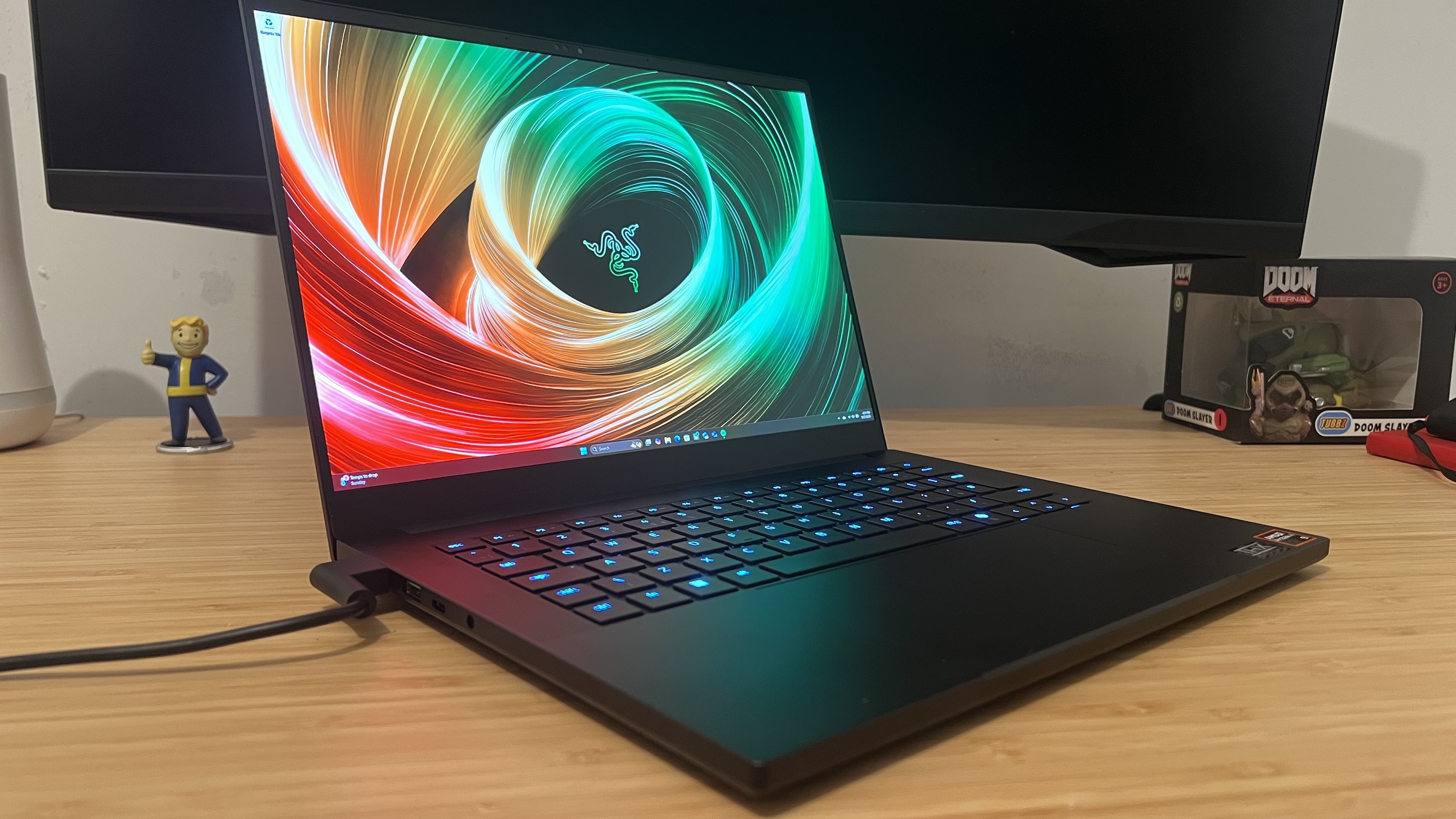
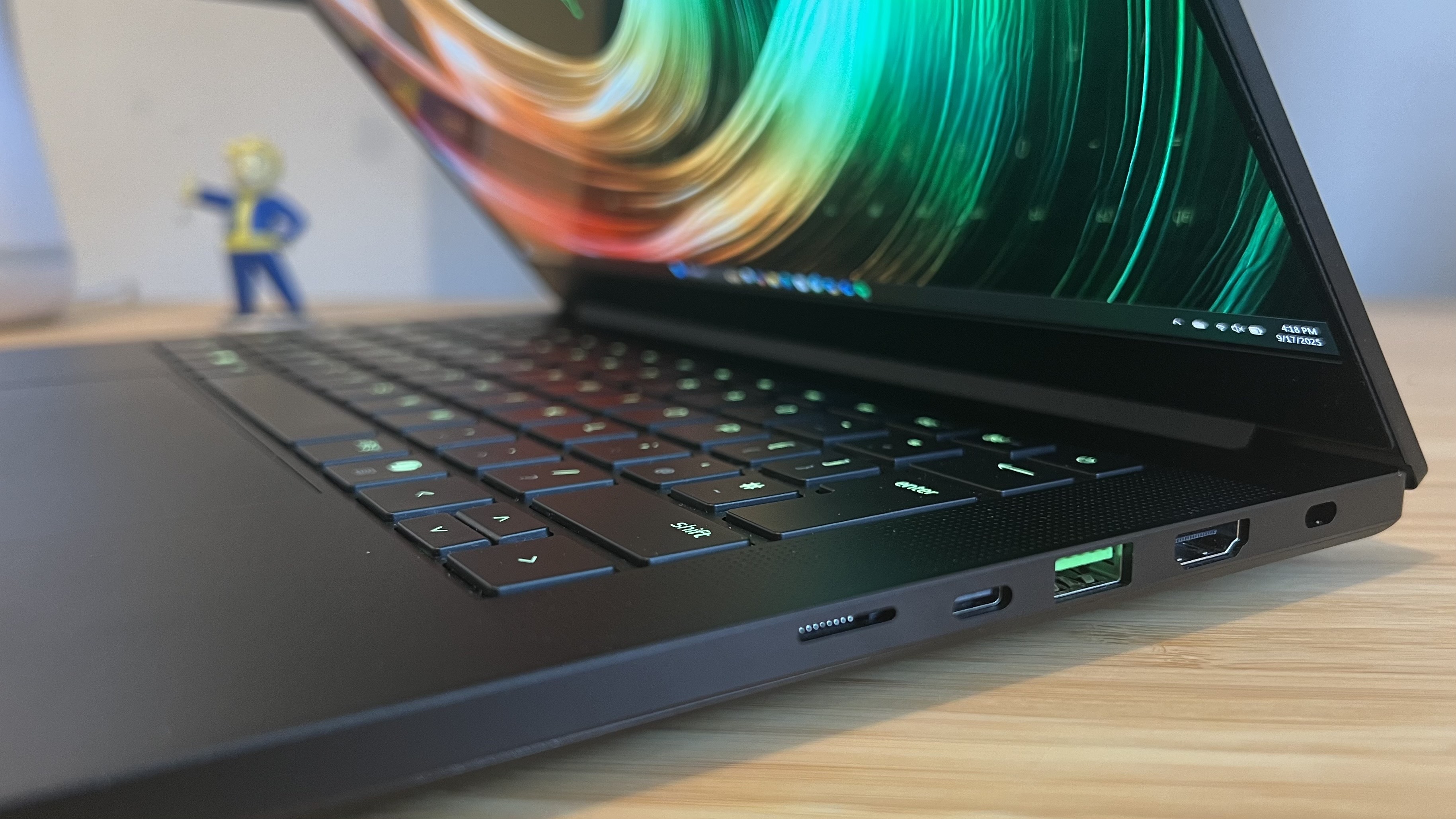
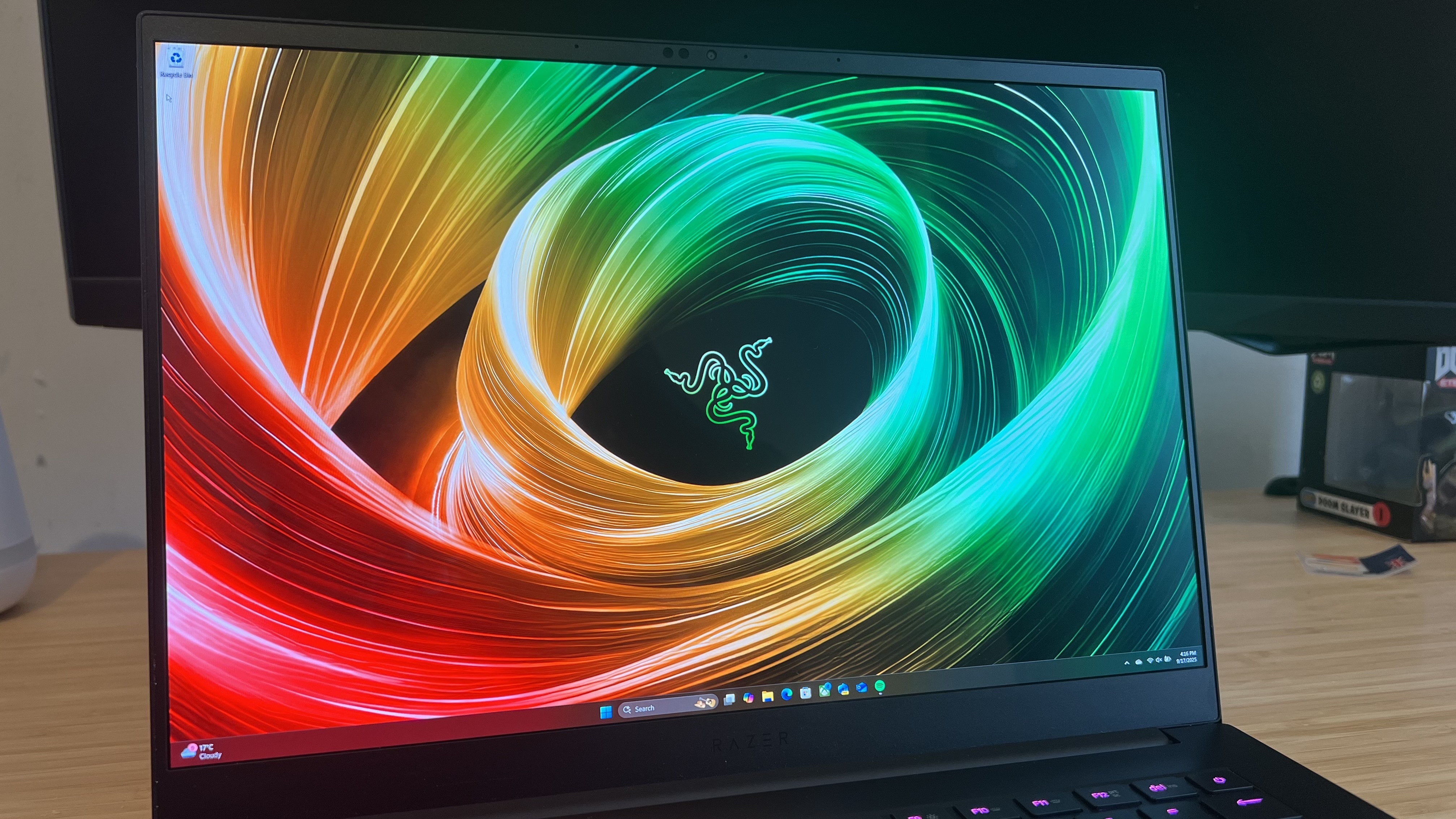
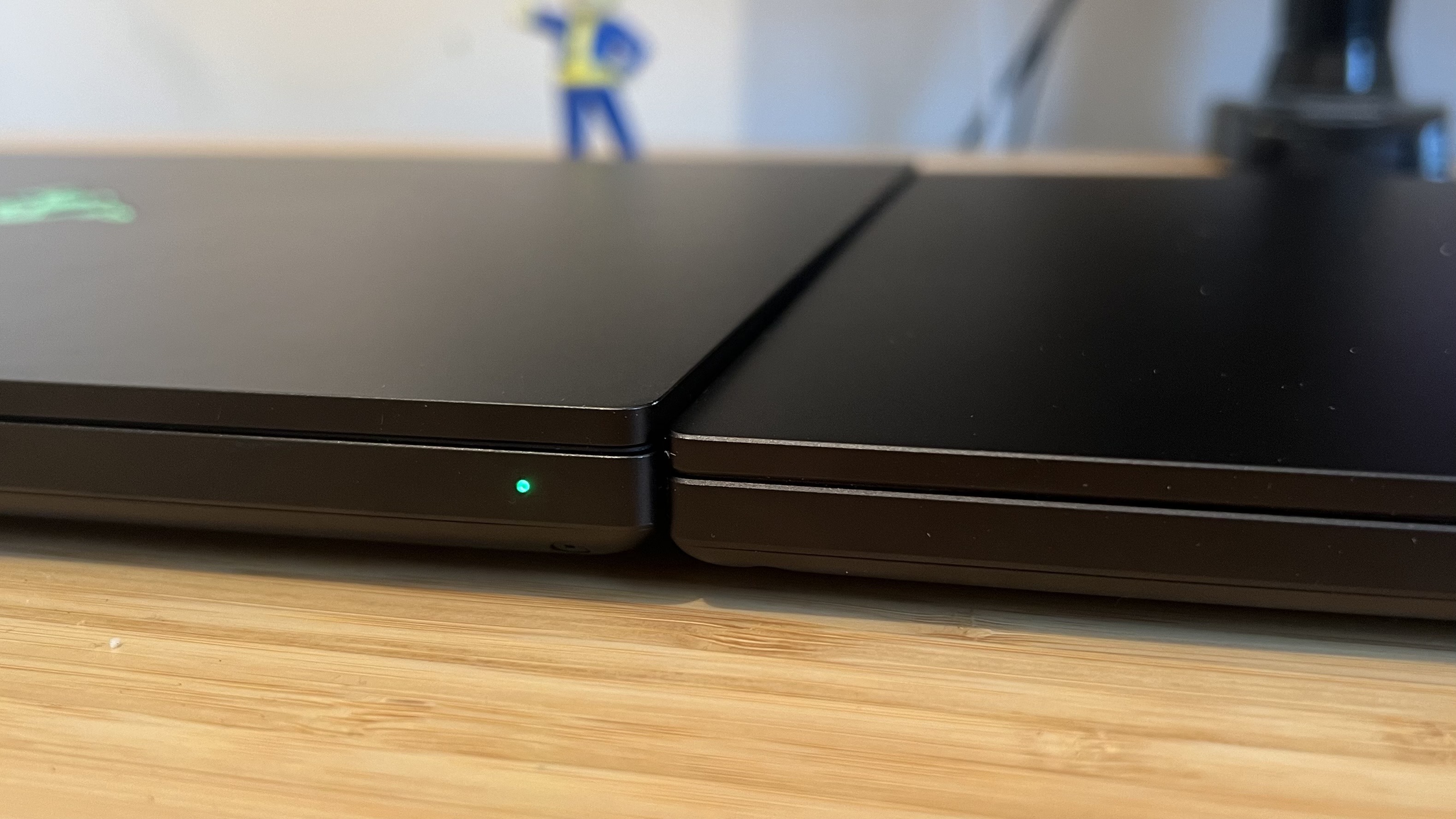
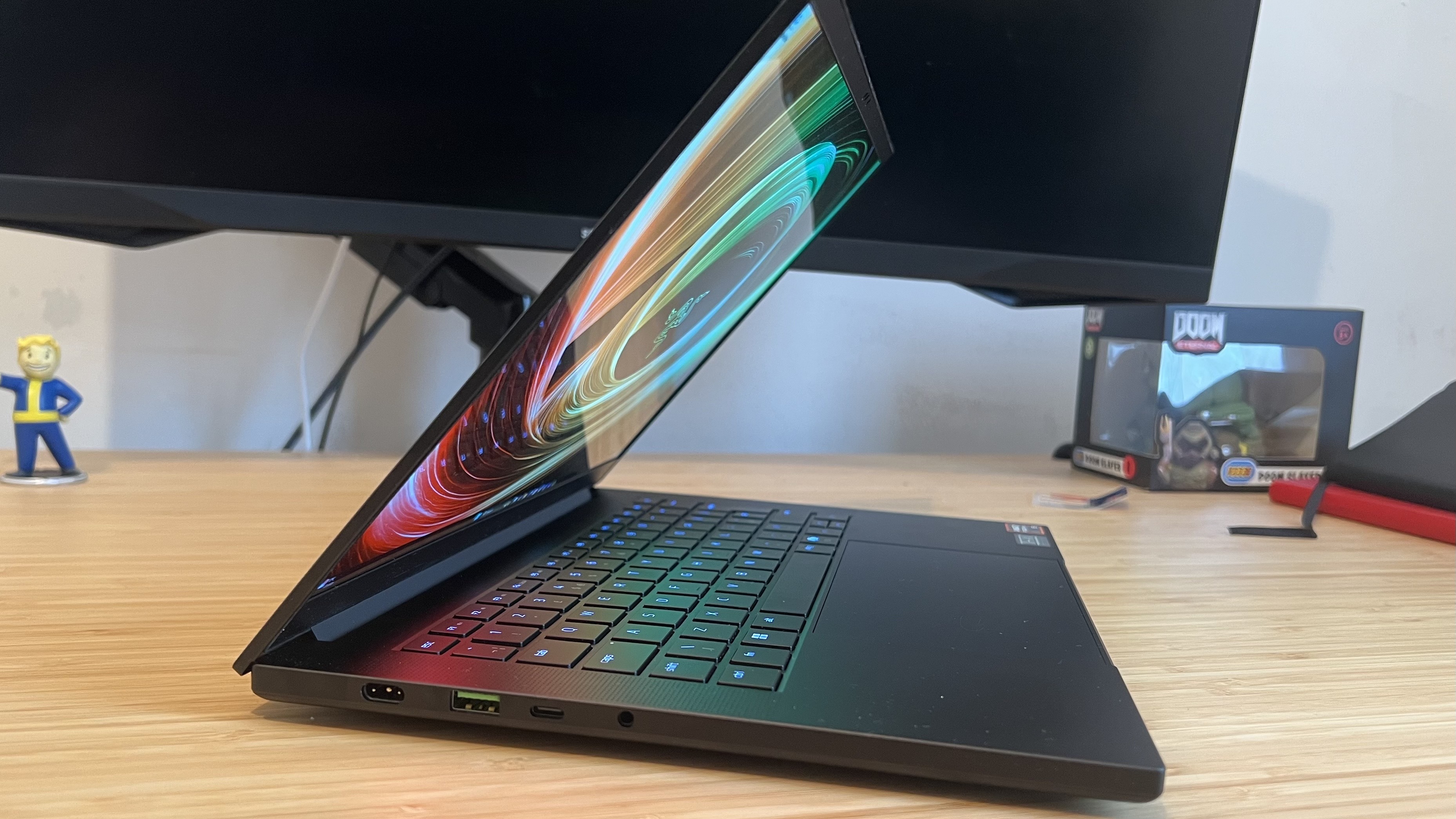
Specifications
Reasons to buy
Reasons to avoid
The 2025 Razer Blade 14 is here, and with it comes a gorgeous OLED display glow-up and a new roster of RTX 50-Series graphics cards. This is Razer's thinnest gaming laptop to date, but it's far from its most powerful.
Instead, the Blade 14 wants to be your secret weapon while out and about. This is a particularly thin and light device, with a premium feel that offers the most luxurious experience I've tried so far. It is, however, capped at an RTX 5070 GPU.
There's an RTX 5060 option available, with less RAM and half the storage, but I expect most willing to drop Razer Blade money on a new laptop will be pushing for that upgrade. This isn't underpowered for its specs by any means - you're still drawing a good deal of power out of that GPU. The Blade 14 could handle anything I threw at it in 1080p, and managed to stay above the line in lighter QHD tests as well. More demanding games are more than playable, but you'll need to venture into Medium settings to keep things running smoothly.
This isn't a Razer laptop designed for pure speed, though. The full aluminum build, and incredibly vibrant, punchy OLED display scream luxury over framerate races. If you're after a gaming laptop for both work and play in style, this is a must-see.
Read more: Razer Blade 14 (2025) review
The best 18-inch Razer laptop

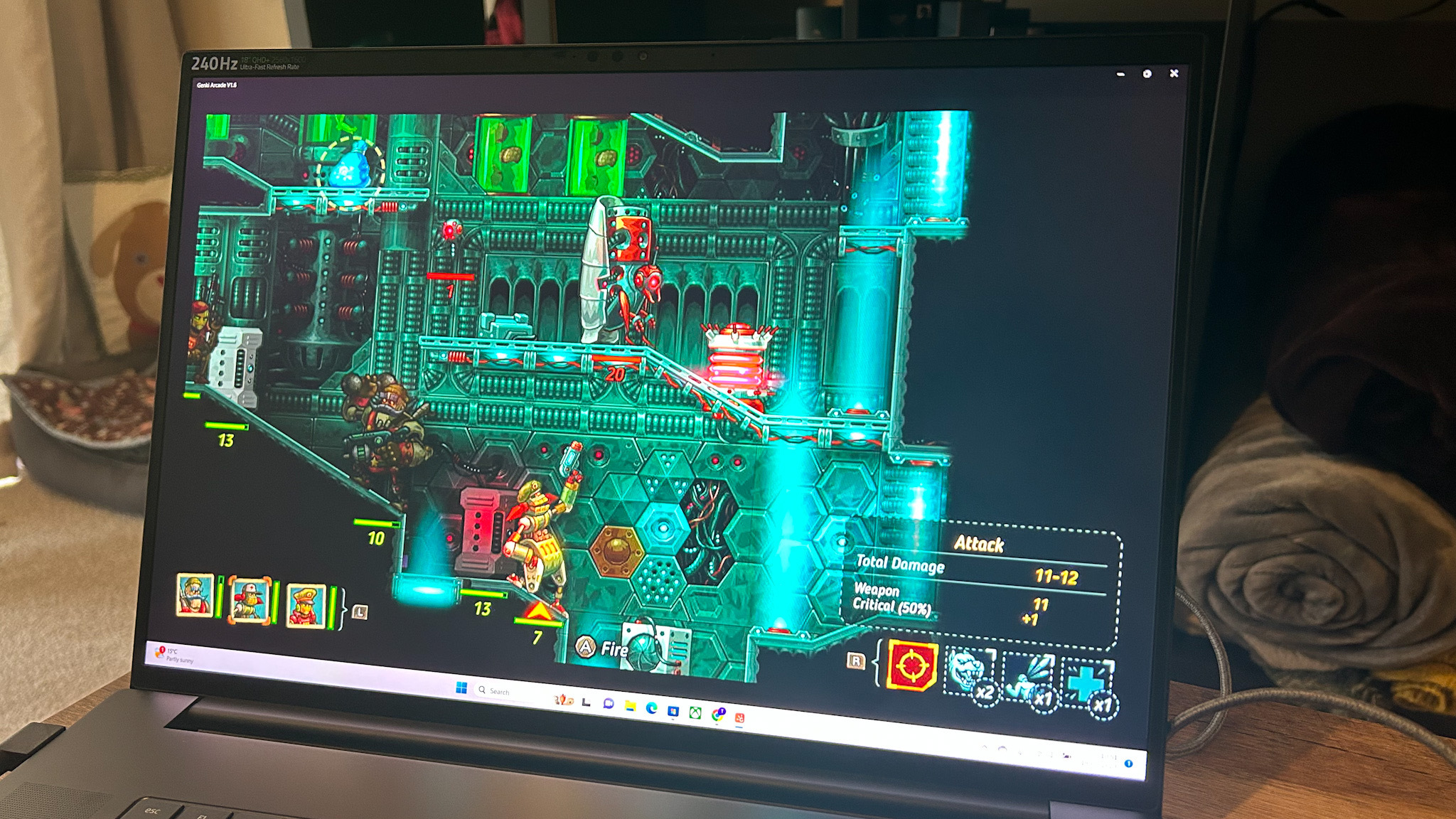
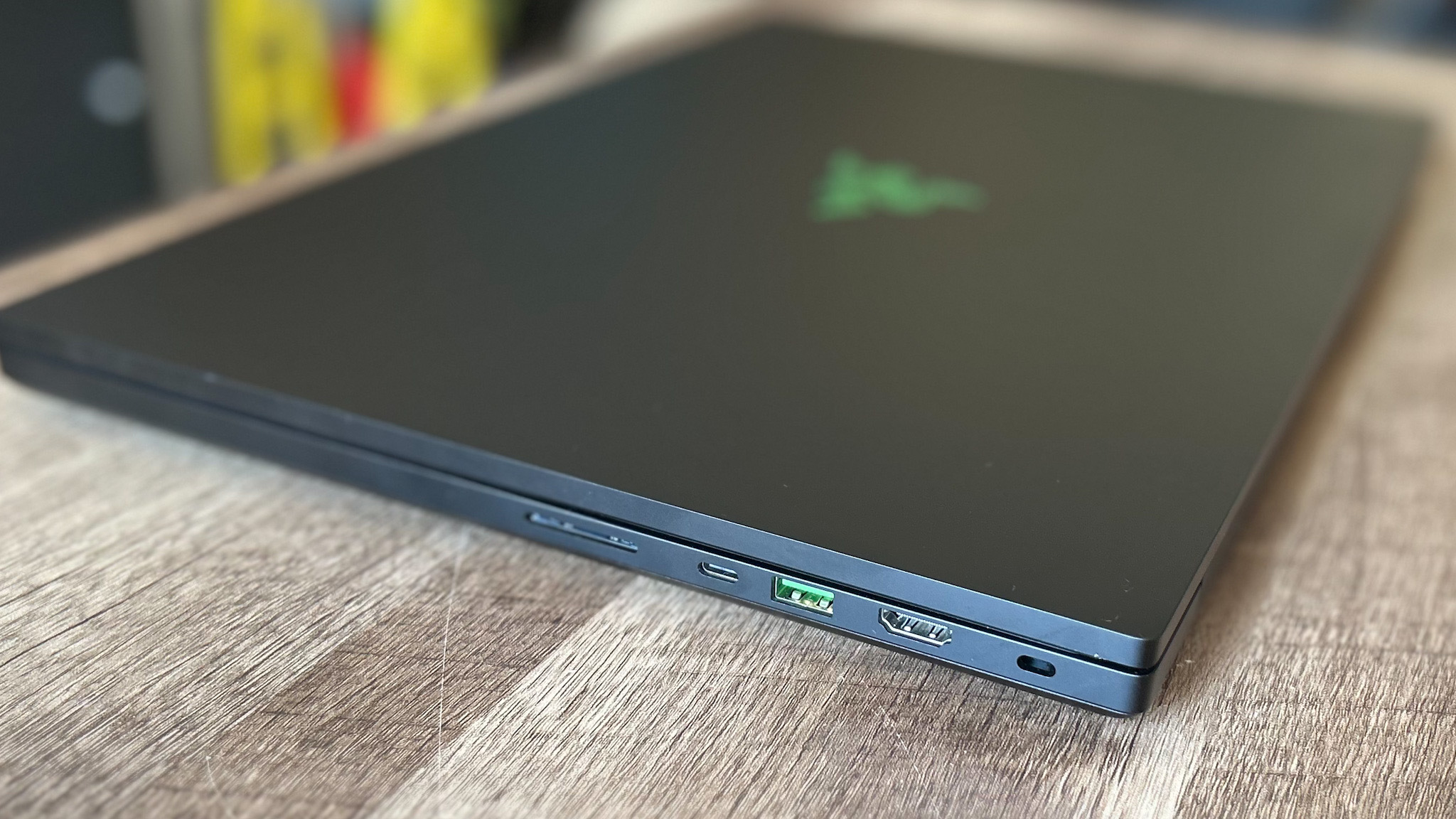
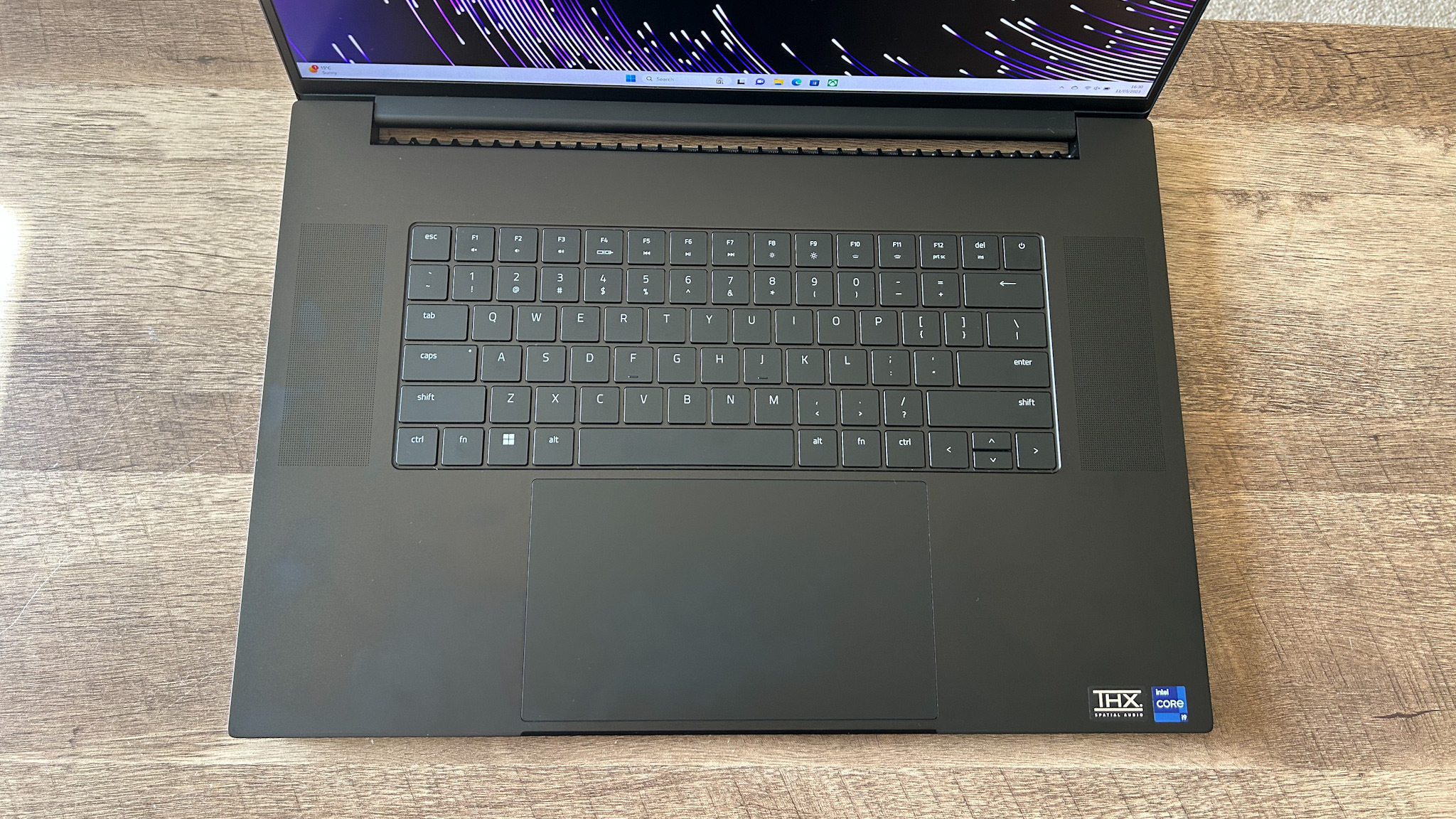
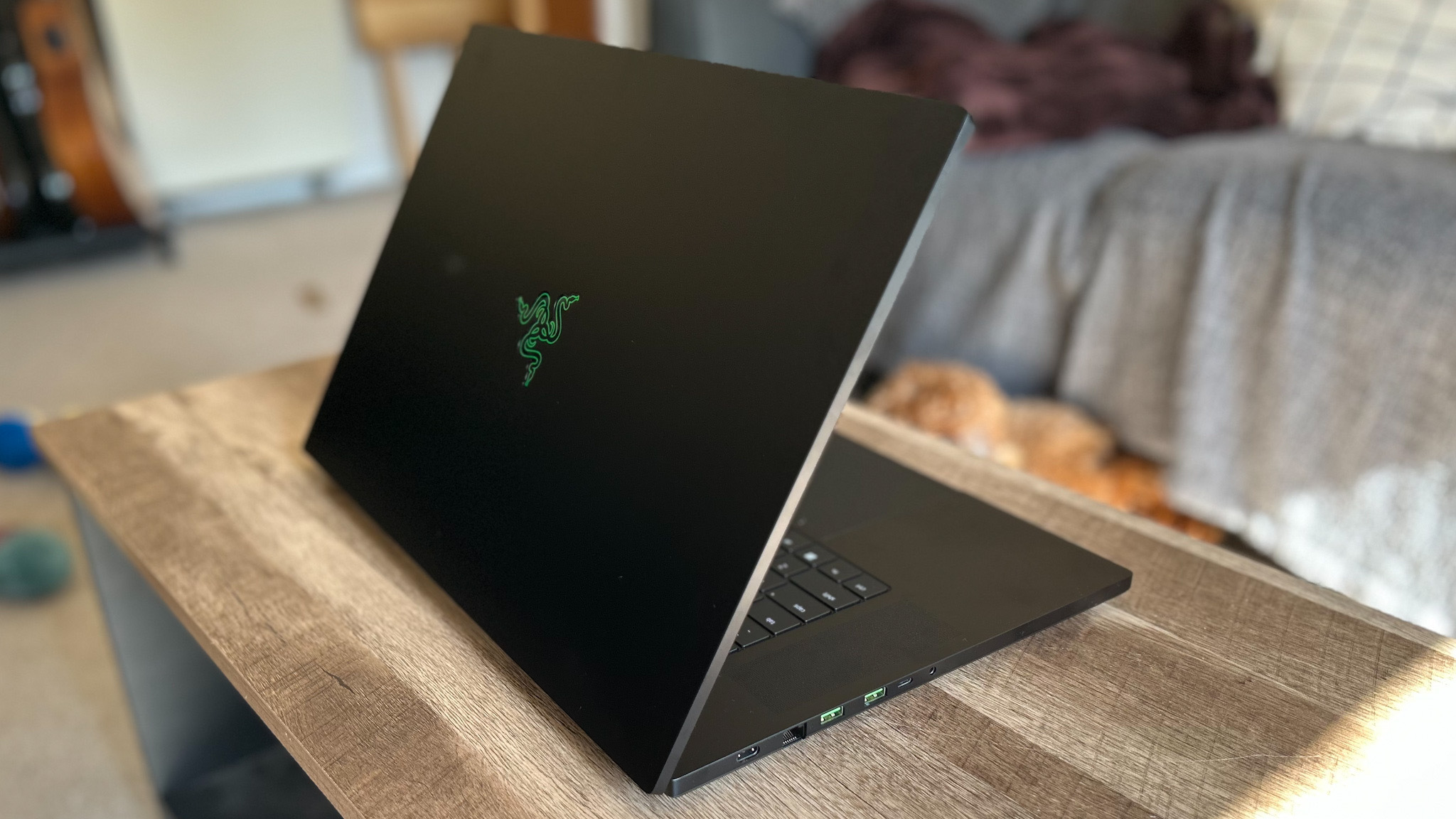
Specifications
Reasons to buy
Reasons to avoid
The Razer Blade 18 is the biggest, baddest, most powerful Razer laptop on the market right now, but it comes with a hefty price tag to accompany it. The new generation device starts at an RTX 5070 Ti configuration at $3,599.99 / £3,099.99 - that's more than you'll pay for an RTX 5080 of other brands' builds.
However, if you're after the slick design of a Razer Blade with the screen size of a larger chassis this is your go-to machine. These rigs can actually run pretty well considering how thin they are. The 21mm thick model I tested (an RTX 4090 configuration) managed to offer some impressive benchmarks, all while still fitting into a (slightly larger) backpack. That's not something you'll find in many other devices, it vastly outperforms the MSI Stealth A18 - its only major slimline competition.
Of course, compared to something chunkier like the 2025 Asus ROG Strix Scar 18 you'll notice a significant drop in performance. That's a little troubling if you're going for all-out power, but if you need a split between portability and immersion, there's plenty going for this rig.
The new models also come with one key upgrade. That Dual Mode IPS display promises already-speedy 240Hz UHD+ resolutions, but can also go turbo with a 440Hz FHD+ resolution at the touch of a button. That means you get silky smooth 4K gameplay for single-player scenarios, and cutting edge high-speed competitive visuals all in the same package.
Storage and RAM have also been increased for the new generation, with the Razer Blade 18 now starting at 32GB RAM rather than the 16GB available on the older devices and ranging up to 4TB in storage space.
Again, you do pay for all those components - and then you pay the Razer tax on top. This is a big strain on the wallet and it doesn't out-perform cheaper but chunkier builds. Still, if you're going solo on Razer's side, this is the 18-incher you need to watch out for.
Read more: Razer Blade 18 review
How we test Razer laptops

I review a massive number of gaming laptops, so trimming that list down to the best Razer models requires standardized tests and plenty of play time. I follow the same steps to ascertain where a PC sits on the market every time, in an approach that combines industry standard GPU, CPU, and SSD tests with real-world game performance and everyday usability.
I use 3D Mark, Cinebench, PC Mark 10, and Crystal Disk Mark to give me some baseline benchmarks on core performance. Then, I run a series of framerate tests on Shadow of the Tomb Raider, Total War: Three Kingdoms, Cyberpunk 2077, and Horizon Zero Dawn Remastered (though some older machines will be tested across a combination of Black Myth Wukong, Returnal, The Talos Principle 2, Metro Exodus, Red Dead Redemption 2, Hitman 3, and Rainbow Six Extraction) to determine how that performance manifests in actual gameplay.
Of course, I also live with these devices so I'm playing all the latest games on each gaming laptop I test and checking how well they slot into my setup, everyday work life, and portability needs as well.
You can find more information on how we review the products we recommend in our full Hardware Policy, and we're also showing you exactly how we test gaming laptops for more details as well.
Also tested
We've had our hands on Razer laptops for a good few years now, dating back to the old days of the RTX 20-Series. You'll find all the scores we've accumulated over the years just below and more information on some older reviews just underneath.
Razer Blade 16 (2024) | Check Amazon
The previous generation Razer Blade 16 is still knocking around, and uses the same OLED display as the newer model. If the price is significantly lower than the closest related RTX 50-Series configuration, it's still worth a dive.
Razer Blade 14 (RTX 4070) | Check Amazon
The older Razer Blade 14 has been largely stripped from the shelves now, which is a shame as it was a solid piece of kit.
Razer Blade Pro 17
The Razer Blade Pro 17 gave some of the top gaming laptops of its day something to think about, but even its RTX 3080 configuration couldn't keep up with newer devices.
Razer Blade 14 (RTX 3080) | Available at Amazon
The old Razer Blade 14 is still alive and kicking, but its RTX 30-Series internals don't quite hold up against the new releases. Still, if you're after a refurbished model this could be a way to save some cash.
Razer Blade 15 Advanced | Available at Amazon
Considering you'll still regularly find Razer Blade 15 Advanced machines packing super old tech, this one's a non-starter. It was impressive in its day, but by current standards the value just isn't there.
How to choose a Razer laptop

Razer gaming laptops are pricey, so you'll want to make sure you're investing in the right model for your setup, day to day use, and portability needs. There are three sizes to choose from right now, 18-inch, 16-inch, and 14-inch. This is the first decision you'll need to me.
Straight away, the 18-inch model can be struck off the list if you need to travel frequently with your machine. While not as cumbersome as other large form factor devices, the Razer Blade 18 is still difficult to carry even in a sturdy backpack. It also isn't designed to use its battery as efficiently as smaller options either. That leaves us with the 14-inch and 16-inch models. I currently use the 14-inch Razer Blade regularly while out and about, though if I was working from coffee shops or playing on-the-go full time, I would recommend upgrading to the larger Blade 16. The extra screen space does add a little weight to your bag, but the boost to split-screen multi-tasking is well worth it from a productivity standpoint.
If, however, you're going to be keeping your laptop firmly on your desk, then the Razer Blade 18 is going to be your best bet. This is designed to be a desktop replacement, so it expands on the ports available and doubles down on cooling. If the price tag of the 18-incher isn't looking viable, then the Blade 16 is still a great option.
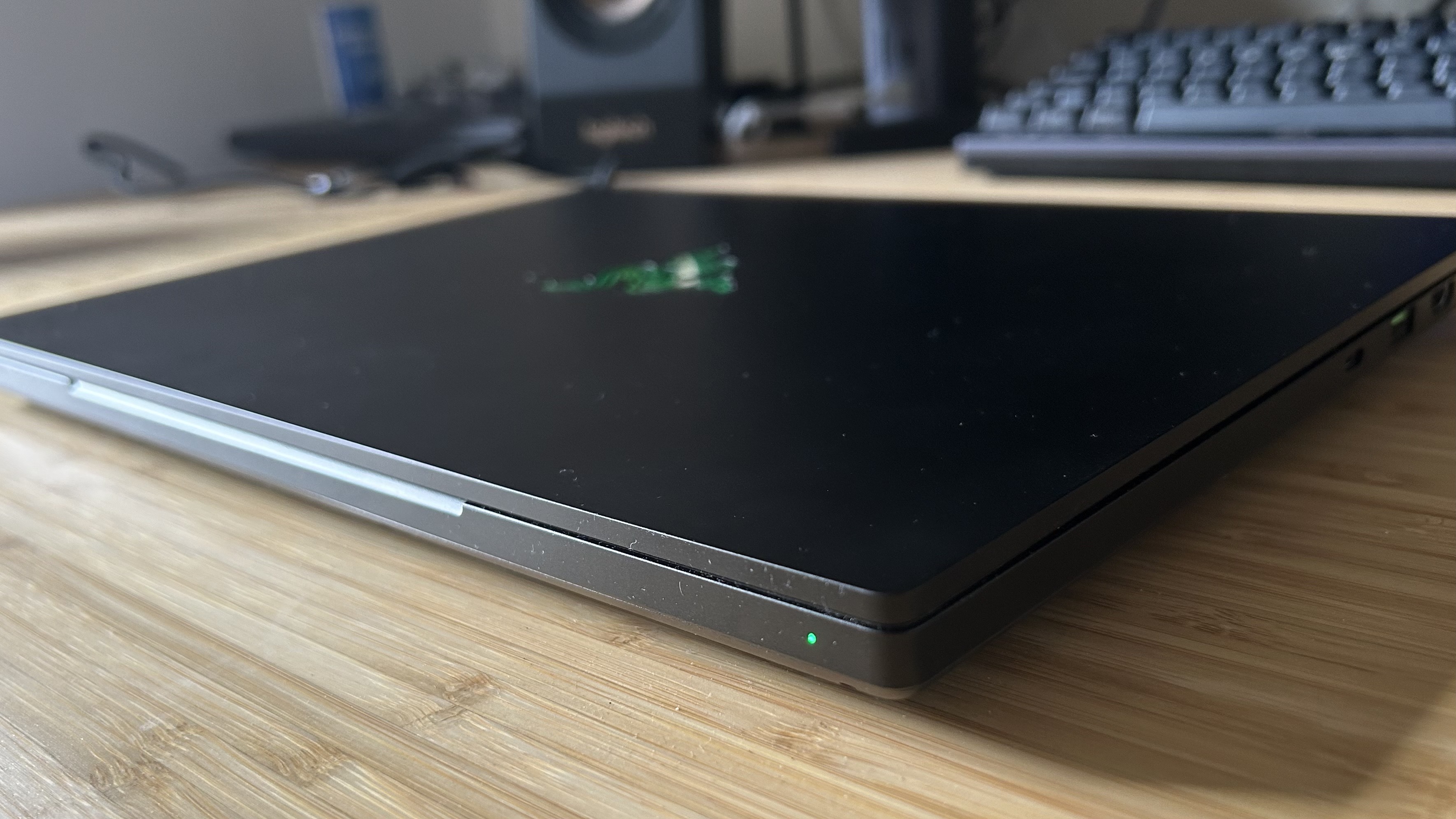
Once you've worked out how and where you will be using your Razer Blade, it's time to think about the GPU configuration options open to you. The Razer Blade 14 tops out at an RTX 5070, whereas the Blade 16 and Blade 18 can go all the way up to an RTX 5090. That's ideal for those looking to chase framerates in a slimline form factor - you'll need all the graphical grunt you can get to achieve Ultra settings in demanding games in a machine this skinny.
Both the Razer Blade 16 and Blade 14 offer high-speed OLED screens in 2025, so you're set for a luxury experience with both now. However, if you're a particularly competitive player I would point you towards the larger 18-inch version. That's because the latest release can swap between high-speed 1080p resolution and a lower speed 4K option at just the press of a button.
At the end of the day, the best Razer laptop for you is going to be the one that fits within your portability needs, offers the right components to see you through your daily play without over-spending on power, and throws it all up on a display that can keep up.
Razer laptops FAQ

Are Alienware or Razer laptops better?
Razer and Alienware are two of the biggest names in the laptop business, but they cater to slightly difference markets.
Alienware builds bulkier machines with less of a focus on everyday portability and display quality, instead leaning more into performance with a larger chassis and more robust cooling system.
Meanwhile, Razer prefers to keep things lean - these systems put more focus on luxury feel while pumping the rest of its energy into its display. That means a slimmer machine, but one that sacrifices total power compared to Alienware.
If you're only interested in using your laptop at home, plugged into an external monitor, and with the highest-performing components available, you're better off with Alienware. If you need a laptop for both work and play on the go, and you want to feel your investment more in everyday build quality and design, Razer is your best bet.
Why are Razer laptops expensive?
These are luxury builds with high-end materials and a some top-of-the-range displays as well. That goes some way to explaining the increased price expected of a Razer machine - the rest is brand building. Razer does charge more for its gaming gadgets across its many hardware ranges, which naturally adds a little extra to the final price of its most expensive gadgets.
If you're not sold on Razer, be sure to check out the best Alienware laptops and the best Asus gaming laptops we've tested so far.
Weekly digests, tales from the communities you love, and more

Managing Editor of Hardware at GamesRadar+, I originally landed in hardware at our sister site TechRadar before moving over to GamesRadar. In between, I've written for Tom’s Guide, Wireframe, The Indie Game Website and That Video Game Blog, covering everything from the PS5 launch to the Apple Pencil. Now, i'm focused on Nintendo Switch, gaming laptops (and the keyboards, headsets and mice that come with them), PS5, and trying to find the perfect projector.
